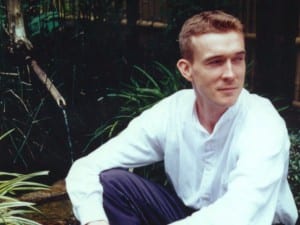Christoph Benjamin Schulz, guest curator at Tate Liverpool, is a German research scholar at the University of Bochum with a particular interest in and extensive knowledge of how Lewis Carroll’s work has influenced the visual arts. Alice in Wonderland ran at Tate Liverpool until 29 January 2012. www.tate.org.uk/liverpool
How would you explain the perennial popularity of Charles Lutwidge Dodgson’s creation (written under the pseudonym Lewis Carroll) and what is it about the work that inspires visual artists?
For me, one of the main draws is the importance of perception. Perceptions may change due to the development of technique, mass media and society, but we are still dependent on our senses. In Alice, Dodgson continually returns to issues relating to perspective and the search for personality and identity in the fantastic worlds he creates. On another level, the stories are very much about conversation and communication via language. This capacity and necessity to communicate is a very basic theme for everyone as social human beings.
Could you talk us through some of the key pieces in the show?
We are very proud to be showing Charles Dodgson’s original manuscript of Alice’s Adventures Under Ground for the first time in a gallery setting. We are also showing works by artist friends of Dodgson from the Pre-Raphaelite era, a selection of Surrealist works by Dalí and Ernst, and work by the British Surrealists who were known as the “Children of Alice.” There is also a display of great contemporary works (Tim Rollins, Kiki Smith, Luc Tuymans), which mirror the richness and complexity of the reception of the Alice books and of Alice in a wider sense.
Many artists have used Alice as a symbol for the chasm between the real and the virtual. How compatible are these themes with this show?
Dodgson’s Alice books deal with the transformation of something real into something highly fantastic. In that sense, the Surrealists saw him as a surrealist “avant la lettre.” Tenniel’s illustrations also conceived an ongoing play with the iconography of Alice, which was important for many of our artists, particularly those who play with the process of understanding and creating meaning.
The number of artists who have referenced Alice in art from the 1930s onwards is almost overwhelming. How has this influenced the process of curating the show?
The sheer quantity of works relating to or inspired by Alice is fascinating and proved to us the importance and relevance of this exhibition. We had to develop a strong and convincing curatorial concept in order to structure it. We wanted to show artistic responses and approaches on different levels, ranging from very literal depictions or explicit Alice references to thematic and atmospheric connections. In speaking to contemporary artists about the exhibition, they have suggested works in which they saw a link to Alice, such as Dan Graham’s Girl’s Make-up Room (1998–2000).
What impact do you hope Mel Bochner’s reprisal of his seminal 1969 work Measurement: Eye-level Perimeter will
have on viewers?
Mel Bochner’s Measurement: Eye-level Perimeter (Ask Alice) (1969/2011) is a wonderful piece. In the new version the line running across the walls and the pillars of Wolfson Gallery at Tate Liverpool is at the exact height that Alice grows to at the beginning of the book, so not only do we perceive the exact size of the room, but also our own size in relationship to the world that Alice experiences. In addition to that, a strange optical illusion means that the height marked on the pillars somehow appears to be higher than that on the walls. It’s an allegory for one of the most important messages of the Alice books: what we see, think and know is essentially dependent on our point of view and perspective.
After its showing at Tate Liverpool, the show will tour to MART, Italy and Kunsthalle Hamburg, Germany. Do you think audiences will fully appreciate the show’s themes outside its literary home?
Although the books were created in England, the stories don’t lose their meaning outside the country’s geographical borders or even outside the English speaking regions. Being translated in many ways enhances their meaning and lets us read and understand the original work differently. Walter Benjamin expressed the idea that a translation doesn’t take the essential away from the original text but, in fact, adds a layer. From that point of view, there are many more perspectives on this text thanks to its many different translations. One could even speak of the works in the Tate Liverpool exhibition as “translations” of the text in the visual arts.




